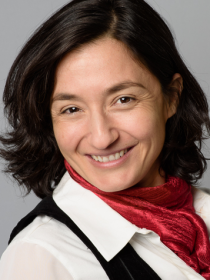Top Qs
Timeline
Chat
Perspective
Maria Antonietta Loi
Italian physicist From Wikipedia, the free encyclopedia
Remove ads
Maria Antonietta Loi (born 4 May 1973) is an Italian physicist who is a Professor of Optoelectronics at the University of Groningen and member of the Zernike Institute for Advanced Materials. Her research considers the development of functional materials for low-cost, high efficiency optoelectronic device. She was awarded the 2018 Netherlands Physical Society Physics prize (Physicaprijs). In 2020, she was elected Fellow of the American Physical Society. In 2022 she became a member of the Royal Netherlands Academy of Arts and Sciences (KNAW) and of the European academy of Science (EurASc). Loi is Deputy Editor-in-chief of Applied Physics Letters.
Remove ads
Early life and education
Loi was born in Quartu Sant'Elena, Sardinia.[1][2] She studied physics at the University of Cagliari. She was awarded honours for her undergraduate degree in 1997, before embarking upon a doctoral research program. After earning her PhD she moved to the Johannes Kepler University Linz, where she worked as a postdoctoral researcher on organic solar cells.[3] After one year in Austria she returned to Italy, where she joined the Italian National Research Council Institute for Nanostructured Materials.[4]
Remove ads
Research and career
In 2006, Loi was appointed Assistant Professor at the University of Groningen, and awarded a Rosalind Franklin Fellowship.[5] Her early work considered the investigation of organic semiconductors and carbon nanotubes photophysical and optoelectronic properties.[6] She was made Chair of the Department of Photophyics and OptoElectronics in 2011, and Full Professor in 2014.[7]
Loi's research considers the development of solution processable semiconductors and hybrid nanomaterials.[8] In particular, she has explored perovskites for solar cells and X-ray detectors.[9][10] She has shown that Sn-based perovskites have intriguing physical properties such as showing photoluminescence from hot-carriers with long lifetimes.[11]
Remove ads
Awards and honours
- 2011 Minerva Prize[12]
- 2013 European Research Council Starting Grant[13]
- 2013 Elected to AcademiaNet[14]
- 2018 Physica Prize[15]
- 2020 Elected Fellow of the American Physical Society[16]
- 2022 European Research Council Advanced Grant[17]
- 2022 Elected Member of the Royal Netherlands Academy of Arts and Sciences[18][19]
- 2022 Elected Fellow of the Royal Society of Chemistry
- 2022 Elected Fellow of the European Academy of Sciences[20]
Selected publications
- Haotong Wei; Yanjun Fang; Padhraic Mulligan; et al. (21 March 2016). "Sensitive X-ray detectors made of methylammonium lead tribromide perovskite single crystals". Nature Photonics. 10 (5): 333–339. doi:10.1038/NPHOTON.2016.41. ISSN 1749-4885. Wikidata Q60670575.
- Shuyan Shao; Jian Liu; Giuseppe Portale; Hong-Hua Fang; Graeme R. Blake; Gert H. ten Brink; L. Jan Anton Koster; Maria Antonietta Loi (22 September 2017). "Highly Reproducible Sn-Based Hybrid Perovskite Solar Cells with 9% Efficiency". Advanced Energy Materials. 8 (4): 1702019. doi:10.1002/AENM.201702019. ISSN 1614-6832. Wikidata Q60670424.
- Markus C Scharber; Markus Koppe; Jia Gao; et al. (1 January 2010). "Influence of the bridging atom on the performance of a low-bandgap bulk heterojunction solar cell". Advanced Materials. 22 (3): 367–370. doi:10.1002/ADMA.200900529. ISSN 0935-9648. PMID 20217720. Wikidata Q60671035.
Remove ads
References
Wikiwand - on
Seamless Wikipedia browsing. On steroids.
Remove ads

